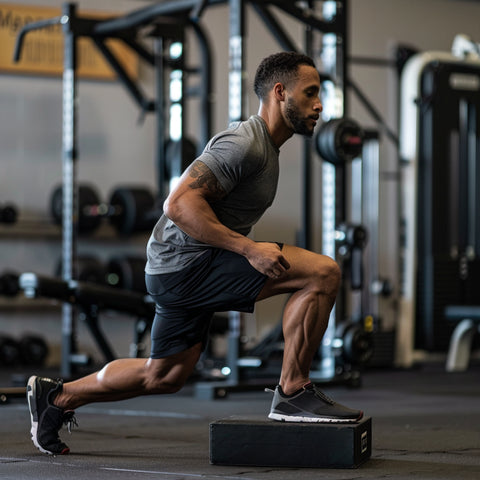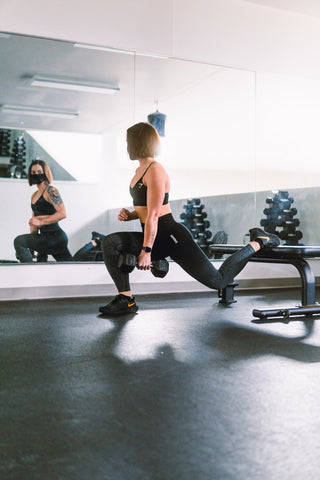
Lunges are a functional way to improve your lower body's strength and stability.
But unlike most forms of lunges, your feet remain stationary during static lunges.
The static stance provides a regulated movement with all sorts of undervalued benefits.
In this post, we’ll cover what makes static lunges so effective, how to complete them, mistakes, tips, variations, alternative exercises, and frequently asked questions.
Why Static Lunges?
Improves lower body strength by focusing on quadriceps and glutes.
Improves balance and stability, lowering the risk of accidents and injuries.
Mimics everyday functions (climbing stairs, walking, bending over, standing up, etc.)
ZERO equipment is required and can benefit all fitness levels
Eliminates the forced exertion and potential injury that comes from the final push of an alternating lunge.
Addresses muscle imbalances - working 1 leg at a time can help even out disproportionate strength.
Low-impact workout with the option to increase weight in a variety of forms (barbell, dumbbells, kettlebells, sandbag, smith machine, weighted plate, sandbag, etc.).
Utilizes the core, improving overall stability and posture.

Static Lunge - How To
Starting stance: Get into a lunge position by stepping one foot forward and the other back, forming a split stance. Your leading foot should be level on the ground, while the other is on its toes.
Lowering Phase: While keeping your chest straight and your core engaged, bend at the knees and lower your body until your back knee is almost touching the ground. Focus on the bend of your front leg, but try to sit back into the stance. Both knees should be at a roughly 90-degree angle.
Returning to start: Concentrate on your front leg and push through the heel of your foot, raising your body back to its starting position. If the movement feels too easy, increase the weight.
Repetitions: Complete enough reps and switch legs.
Mistakes
Knee Position: Do not allow the front knee to extend too far past the toes. This will place unnecessary strain on the knee and ankle joint. Additionally, avoid letting your knee cave inward, this will negatively impact the hips and lower back.

Upper Body Alignment: Leaning too far back or forward reduces the exercise's efficacy and increases the chance of injury.
Foot placement: Placing your feet too close or far apart will likely have an impact on your balance and form.
Tips
Focus on Form: To minimize injury, prioritize good form above the number of reps.
Use a Mirror: Great way to keep yourself honest by maintaining proper posture and alignment.
Practice Slow: If you're a beginner, start with no weights to learn the proper form before adding weight. Mastering the form combined with the balance aspect of the lunge can take a few sets to get used to.
Primary Muscles Worked
Quadriceps: Knee flexion throughout the movement targets all 4 parts of the quadricep including the rectus femoris.

Glutes: Gluteus maximus, gluteus medius, and gluteus minimus (left to right) are all active during static lunges.

Adductors: Inner thigh muscles - present throughout the movement.
Secondary Muscles Worked
Hamstrings/calves: Aid in hip extension and the upward pushing motion of the exercise.
Core/lower back: Act as stabilizers throughout the movement. Notably the erector spinae in keeping an upright torso.
Variations & Alternatives
Reverse lunges, walking lunges, and split squats are all variations of static lunges that offer similar benefits.
If you prefer static-style leg workouts, I recommend squats, wall sits, and side lunges.
A few of my favorite lunge-style exercises include:




Static Lunge vs. Split Squat
Both split squats and lunges have a slightly similar stance and target the same muscles, however, the split squat is far more difficult to perform:
A split squat involves elevating one foot behind you on a bench while performing a squat with one leg. The exercise resembles a static lunge but with the extra difficulty of elevating the back foot.

The adductors play a larger role throughout the split squat. You will find your stabilizing muscles working harder to compensate for the added difficulty of balancing on one leg.
FAQ
What is an ATG Split Squat?
An atg (ass to grass) split squat is a hybrid variation of a deep squat and lunge.
The movement is great for improving hip, knee, and ankle mobility as well as building your quads and glutes.
The intense mobility of the atg split squat is why the exercise is considered an advanced movement.
What’s the best form of weight to use with static lunges?
Your choice of weight should be determined by access to equipment and comfortability. A few options include; barbell, dumbbells, kettlebells, sandbag, smith machine, weighted plate, and weight vest.
I prefer holding dumbbells/kettlebells at my side, or a plate or dumbbell at my chest.
What can I do instead of lunges?
Lateral step-ups are an excellent alternative to static lunges as they target many of the same muscles and have similar movement patterns.
If lunges and step-ups aren't your style, try squats, leg press, leg extensions, wall sits, or single-leg squats to receive similar benefits.
How do I complete deficit reverse lunges?
Grab a plate or small box with a height of 3-8 inches.
Stand on the surface, your feet shoulder-width apart.
Move your left foot back and bend your left knee until it is just above the ground.
As your range of motion increases, your right knee will bend at a lesser angle.
Lean your body slightly forward, making sure your back is flat.
Lift your rear leg and return to the plate/box.
Repeat for several reps and switch sides.
What's the difference between abductors and adductors?
Abductor muscles, located on the outer hips and thighs, push the limbs away from the body and are essential for stability and lateral movement.
Adductor muscles, found in the inner thighs, draw the legs toward the center of the body and help in actions such as walking and sprinting.
Strengthening all muscle groups increases stability, agility, and mobility while limiting the chance of injury.
Sources:
[1] Davies, Clair, and Amber Davies. The Trigger Point Therapy Workbook: Your Self-Treatment Guide for Pain Relief. 3rd ed., New Harbinger Publications, Inc., 2013.


